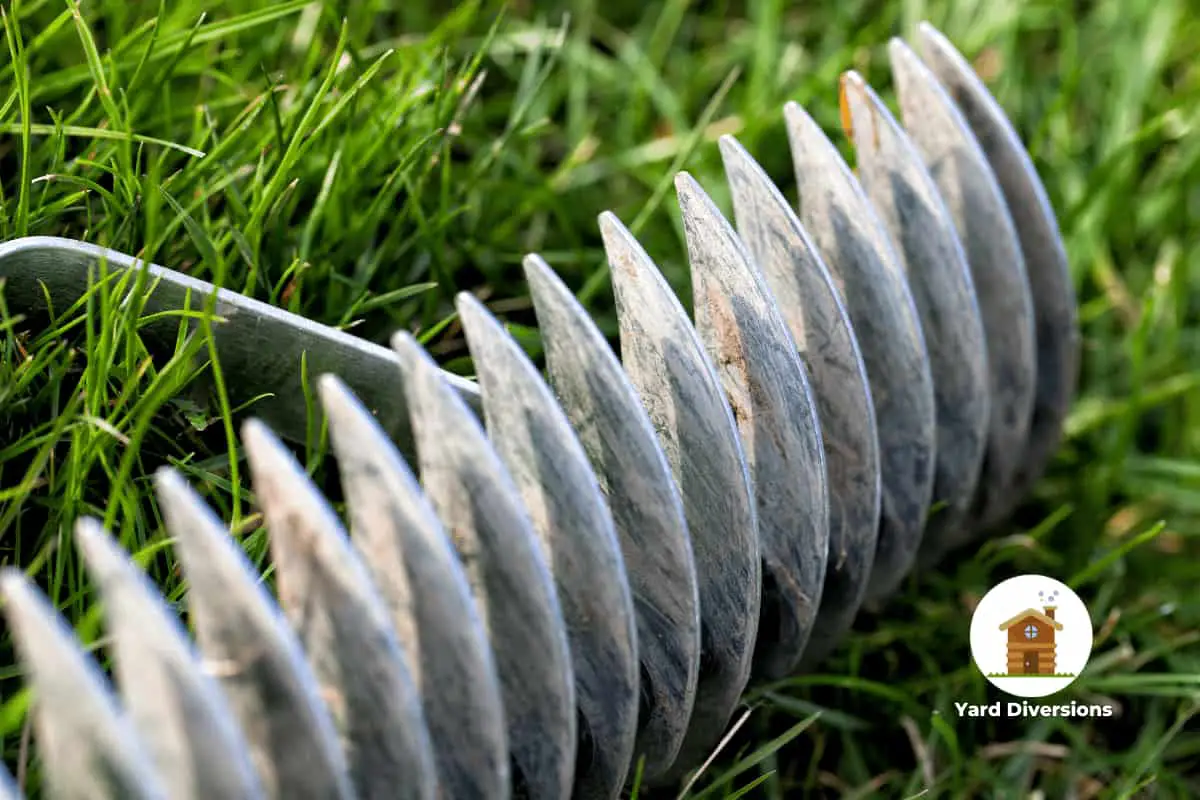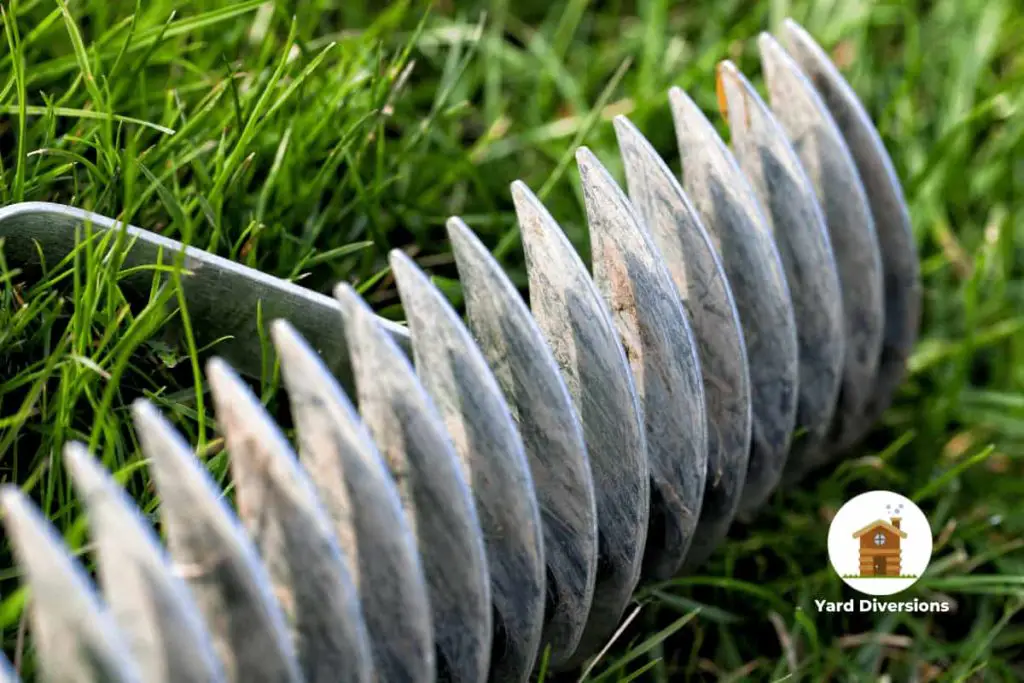A build-up of thatch can cause problems for your lawn, stopping water and nutrients from getting to the soil. But you will need to be careful about dealing with this issue.
If done incorrectly, you might be harming your grass. So let’s look into it, can dethatching can hurt your lawn?
Dethatching can prove detrimental to a lawn if done at the wrong time. Early spring detaching hits the lawn hard because the lawn is still recovering from winter injuries, ice damage, and snow mold. Detaching in mid-to-late fall can also damage the grass as it is dormant.
Because dethatching can place a lot of stress on your grass, it’s essential to consider how you do it. This will allow you to limit the damage.
Keep reading to learn more about the dethatching process and how to perform it properly.

How Does Dethatching Affect Your Lawn?
Thatch is the layer of organic material that builds up above the grass blades. A thin layer of thatch can prove to be quite beneficial for your lawn.
Some of the important functions that it performs include:
- Helping to regulate the soil temperature. This is especially important during the winter months.
- Providing nutrients. As the organic materials break down, they release nutrients into the soil. This will allow the grass to form stronger roots.
- Retaining moisture in the soil. It does this by forming a layer that will block evaporation. This is especially important for those living in an area that is impacted by droughts.
- Protecting from pests. The thatching can provide a layer of protection against burrowing animals. This can also help to protect it against people standing on the grass.
However, too much thatch can start to cause problems. This can include blocking the flow of air and water to the lawn. As a result, the grass won’t grow as strongly. In some cases, it can even lead to dead patches. To prevent this, many people opt to remove the thatched layer.
But the dethatching process can place a lot of stress on your lawn. Some of the most common issues include:
- Exposing the underlying soil. This can result in moisture loss, drying out the grass. This is particularly bad when done during the drier winter months.
- Taking away nutrients. If the whole organic layer is removed, there might not be any nutrients going into the soil. Without this, the grass roots will start to become weaker.
- Allowing weeds to take control. One of the most common issues is that dethatching at the wrong time of the year can allow weeds to gain a foothold in your lawn. Once this happens, it can be expensive and time-consuming to remove the weeds.
Often, people will dethatch at the wrong times of the year. This will amplify the damage.
For example, you might be dethatching during winter or at the start of the spring.
This is when the grass is just starting to overcome the damage inflicted by the colder winter months.
Since the root system is still weak, it will find it harder to bounce back.
How Do You Know When It’s Time to Start Dethatching?
First, you must consider whether you need to dethatch at all. As we mentioned, a thin organic layer is beneficial for the grass.
You must poke a hole next to the grass blades to measure the thatch. This can be done with your finger or a pencil. Keep going down until you feel the soil.
Measuring the depth of this hole will tell you how much thatching there is.
A healthy lawn should have around half an inch of thatching. Anything more than this will be a problem, and you will have to start dethatching.
You should perform this test yearly to keep an eye on the amount of organic material you have.
Depending on the type of grass you have, you might need to dethatch once a year. Though most of the time, you’ll have to dethatch once every two to three years.
When Is the Right Time Of Year To Dethatch Your Lawn?
Most of the time, the damage will be caused by dethatching at the wrong time of the year. The ideal time will vary a little, depending on whether you have a cool or warm grass season.
Generally, you will need to start dethatching during the mid-to-late spring. You can also start to dethatch at the start of fall. But leaving it to mid-to-late fall will be too long, and there is a chance that you will damage your grass.
The key is ensuring the grass grows strongly before you start to dethatch. This will ensure that they can easily recover from the stress of dethatching.
Tips To Dethatch Without Harming Your Lawn
If you are planning on dethatching your lawn, you should keep a few other tips in mind.
These are:
- Build moisture in your lawn before you dethatch. You should make sure that the lawn is moist before you start dethatching. But you don’t want it to be damp, as this will make the process too messy.
- Choose a cooler day. The heat of the sun can place a lot of stress on the lawn. It can also dry the lawn out faster. As a result, you should choose a day that is a little overcast and cooler.
- Mow the lawn before you dethatch. You should mow it to half its normal height. This will make it easier to remove the thatching layer.
- Protecting from weeds. To stop weeds from popping up you should spray the lawn with a pre-emergent herbicide. Do this shortly after you have removed the thatch.
- Aerate your lawn regularly. This will make it easier to prevent thatch from building up in the future.
How Can Dethatching Help Fix the Damage from Dog Urine on Your Lawn?
Dethatching is crucial for repairing the damage caused by dog urine on your lawn. One of the reasons dog pee kills grass is that it creates salt build-up and burns the grass. Removing thatch allows for better water and nutrient absorption, promoting healthier grass growth and minimizing the impact of dog urine.
Final Thoughts on Dethatching Hurting Your Lawn
Dethatching your lawn is a necessary process, ensuring that water and nutrients can flow easily into the soil.
But you will need to be careful about the time of the year when you are dethatching. Mid to late spring is ideal for most species.
Thanks to the strong growth at this time, your grass will easily bounce back from the stress, so you can enjoy a beautiful lawn.


